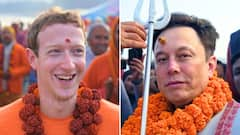Quantum Computing: What Is It? How Is It Different From Classical Computing? How Does It Work?
Quantum computing is a rapidly emerging, new-generation technology that involves a type of computer 158 million times faster than the most sophisticated supercomputer in the world.

Quantum computing is a rapidly emerging new-generation technology that involves a class of computer 158 million times faster than the most sophisticated supercomputer in the world, and harnesses the laws of quantum mechanics to solve problems too difficult for classical computers, and deliver huge leaps forward in processing power. Quantum mechanics is a branch of physics that explains nature on the scale of atoms, and has resulted in advances such as transistors, lasers, and magnetic resonance imaging, since its emergence in the early 1990s. While classical computers generate bits, a quantum computer has the ability to generate and manipulate quantum bits, or qubits.
Bits are electrical or optical pulses representing zeroes (0s) and ones (1s). Most computers work with zeroes and ones, also known as binary information.
Quantum Bit or Qubit
A qubit is a quantum bit, the counterpart in quantum computing to the binary digit of classical computing, and is the basic unit of a quantum computer. A qubit is made out of a quantum system, like an electron or photon.
A traditional bit can only be a one or zero. However, a qubit can be a one, a zero, or both at the same time, according to a study published by the Institute of Electrical and Electronics Engineers (IEEE).
Since a qubit can be a one and a zero at the same time, a quantum computer does not have to wait for one process to end before it can begin another.
Quantum Computing: History
In 1982, American physicist Richard Feynman said that computing based on classical logic could not controllably process calculations describing quantum phenomena, according to an article published by the National Center of Biotechnology Information (NCBI).
These obstacles could be overcome using computing based on quantum phenomena configured to simulate other quantum phenomena. Not much research on quantum simulation was conducted in the 1980s.
In 1984, American mathematician Peter Shor developed a quantum algorithm which could find the prime factors of large numbers "efficiently". This means that the algorithm could find the prime factors of large numbers in a time of practical relevance.
Quantum Computing: How is it different from classical computing?
Both quantum computers and classical computers try to solve problems, but the way they manipulate data to obtain answers is fundamentally different.
Quantum computers are unique due to two principles — superposition and entanglement.
The counterintuitive ability of a quantum object, like an electron, to simultaneously exist in multiple "states" is known as superposition. For instance, one of the states of an electron may be the lowest energy state in an atom, while another state may be the first excited level. An electron will have some probability of being in the lower state and some probability of being in the higher energy state if it is prepared in a superposition of the two states.
One can understand the qubit, the basic component of information in quantum computing, through the knowledge of superposition.
Bits, in classical computing, are transistors that can be off or on, corresponding to the states 0 and 1, the NCBI article states.
Qubits are different from classical bits due to their ability to be in superpositions with varying probabilities. Quantum operations during computations can be used to manipulate these probabilities.
Once all the qubits are measured, the final result of a calculation is obtained. This causes the quantum state of the qubits to collapse to either 0 or 1.
The phenomenon in which quantum entities are created and/or manipulated such that none of them can be described without referencing the others, as a result of which individual identities are lost, is known as entanglement. For instance, the measurement of one member of an entangled pair will immediately determine measurements on its partner.
Quantum computers are said to obtain their speedup by trying every possible answer to a problem in parallel. Pairs of qubits are said to be entangled when both members of each pair exist in a single quantum state. As a result, changing the state of one of the members will instantaneously change the state of the other member.
A quantum computer takes maximum advantage of entanglement between qubits and the probabilities associated with superpositions to carry out a series of operations. Known as a quantum algorithm, the series of operations helps enhance the probabilities of the right answers, and depress the probabilities of the wrong answers.
The NCBI article states that when a measurement is made at the end of a computation, the probability of measuring the correct answer should be maximised. Quantum computers are different from classical computers because of the way they leverage probabilities and entanglement.
ALSO READ | Internet Of Things: What Is IoT? How Does It Work? How Does It Make Our Daily Lives Better?
Quantum Computing: Why the world needs it
Supercomputers, which are very large classical computers, help scientists solve difficult problems. However, supercomputers often struggle to solve problems with a high degree of complexity, an article published by IBM states. These include the problems with lots of variables interacting in complicated ways and modelling the behaviour of individual atoms in a molecule, among others.
This is where quantum computing comes to the rescue.
If there are lots of doors, all of which are locked except one, and the open door needs to be found, a traditional computer will keep trying each door, one after the other, until it finds the unlocked door. Depending on how many doors there are, the traditional computer may take as long as millions of years to find the unlocked door, an article published by Live Science says.
However, a quantum computer could try all the doors at one, and this is what makes it faster than a classical computer.
A primary motivator for advancing the field of quantum computing is the promise of developing a quantum computer sophisticated enough to execute Peter Shor's algorithm for large numbers. Quantum computers have the potential to deliver tremendous speed-ups for only specific types of problems. These computers are believed to help solve problems related to optimisation, which play important roles in everything from defence to financial trading.
Quantum computers can respond to changing information quickly and examine a limitless number of outcomes and permutations simultaneously, the Live Science article states, citing research by Cornell University.
Quantum Computing: How quantum computers work
Quantum computers are elegant machines that are smaller and require less energy than supercomputers, the IBM article states. While an IBM Quantum processor is a wafer not much bigger than the one found in a laptop, a quantum hardware system is about the size of a car, made up mostly of cooling systems. These systems keep the superconducting quantum processor at its ultra-cold operational temperature.
Superfluids
Just as a desktop computer uses a fan to get cold enough to work, quantum processors need to be very cold to operate. Their temperature should be about a hundredth of a degree above absolute zero. This ultra-cold temperature is achieved using super-cooled superfluids to create superconductors.
Superconductors
The article states that certain materials in IBM processors exhibit an important quantum mechanical effect at ultra-low temperatures. This is an effect in which electrons move through superconductors without resistance. This is what makes the processors "superconductors".
When electrons pass through superconductors, they match up, forming "Cooper pairs", which subsequently carry a charge across barriers, or insulators, through a process known as quantum tunnelling.
When two superconductors are placed on either side of an insulator, they form a Josephson junction.
Control
IBM's quantum computers use Josephson junctions as superconducting qubits. The behaviour of these qubits can be controlled by firing microwave photons at these qubits. In this way, the qubits can be made to change and read out individual units of quantum information.
Superposition and Entanglement
Though a qubit itself is not very useful, it plays an important role by placing the quantum information it holds into a state of superposition. This state represents a combination of all possible configurations of the qubit. Complex problems can be represented in new ways in the complex computational spaces created by groups of qubits in superposition, the IBM article states.
Changes to one member in a pair of entangled qubits directly impact the other. Since superposition and entanglement form the basis of quantum computing, quantum computers use these relationships to find solutions to complex problems.
Quantum Computing: Applications
Quantum computers can simulate the behaviour of matter down to the molecular level, an article published by Massachusetts Institute of Technology (MIT) says.
The batteries of electric vehicles can be improved with the help of quantum computers. For instance, automobile manufacturers like Volkswagen and Daimler are using quantum computers to simulate the chemical composition of electric vehicle batteries.
Quantum computing is also used by pharmaceutical companies to analyse and compare compounds that could lead to the creation of new drugs.
Since quantum computers can navigate vast numbers of potential solutions extremely fast, they can be used for optimisation problems. For instance, Airbus, a European multinational aerospace corporation, is using quantum computing to help calculate the most fuel-efficient ascent and descent paths for aircraft.
The MIT article states that Volkswagen has unveiled a service that minimises congestion by calculating the optimal routes for buses and taxis in cities.
D-Wave Systems, a Canadian quantum computing company, has built a quantum computer, which the firm says is the first and only quantum computer designed for business use.
According to a statement released by the company, the quantum computer, known as Advantage quantum system, has been designed with a new processor architecture with over 5,000 qubits and 15-way qubit connectivity. The firm claims that this enables companies to solve their largest and most complex business problems.
Quantum Computing: Advantages of quantum computers over supercomputers
While a supercomputer may efficiently sort through a big database of protein sequences, it struggles at performing difficult tasks such as observing the subtle patterns in the data that determine how the proteins behave.
Proteins are long chains of amino acids, and fold into complex shapes, making them useful biological machines. It is difficult to figure out how proteins will fold.
A classical supercomputer will try to find out the way a protein folds by using its processors to check every possible way of bending the chemical chain, before arriving at an answer. However, the supercomputer stalls as the protein sequences get longer and more complex.
A chain of 100 amino acids can theoretically fold in any one of many trillion ways, and no computer has the working memory to handle all the possible combinations of individual folds.
Quantum algorithms create multidimensional spaces to solve these problems. In these multidimensional spaces, patterns linking individual data points emerge, the IBM article states.
The pattern, in case of a protein folding problem, might be the combination of folds requiring the least energy to produce. This combination is the solution to the protein folding problem.
Since classical computers cannot create these computational spaces, they cannot find these patterns.
Early quantum algorithms to find folding patterns in efficient ways exist.
An advantage of quantum computers over traditional computers is that the former are relatively small because they do not rely on transistors. Also, they consume comparatively less power.
Quantum computers can potentially revolutionise computation by making some intractable problems solvable.
Quantum computers have not yet reached their full potential. This is because there is a shortage of skilled researchers in the field of quantum computing, and a lack of suppliers or some key components.
However, a few large companies have functioning non-error-corrected quantum computers composed of several tens of qubits. Some of these quantum computers are accessible to the public through the cloud.
If the existing quantum systems work efficiently, a large-scale, error-corrected quantum computer may soon come into existence.






































